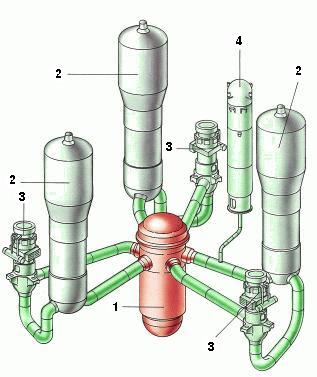12.05.2009 Lauri Myllyvirta Faults have been observed in the primary coolant pipes of Olkiluoto 3 that are being welded together in France. Finnish watchdog STUK has ordered the manufacturer to stop work until the issue is resolved. Potential implications of piping problems for the project
The issue surfaced only a week after severe problems were exposed in the design of electronic control systems of the reactor. The primary coolant circuit and the control systems are the two most crucial parts of a nuclear reactor.
STUK has ordered welding to be stopped until the Finnish investor TVO provides an assessment of the safety significance of the faults. TVO will need to show that the pipes are not damaged in a way that would affect the safety of the plant.

An illustration of the primary cooling system of a pressurized water reactor, such as the French EPR. Primary coolant pipes are colored green.
When pipes connecting the reactor and the steam generators have been welded during the spring, faults have been observed on the outer surface of the pipes. The faults are microscopic fractures on the grain boundaries of the 76mm thick wall of the steel pipes.
This is the second time the fractures have been observed. Three welds have been made already out of a total of four. In the inspections carried out after the first weld, grain boundary fractures were observed in a 190 mm long section of the weld. The fractures were 1-2mm long and up to 1.8mm deep. Welding was suspended and samples were taken to determine the cause. On the basis of assessments made, STUK required intensified oversight of welding. No fractures were observed after the second weld. When the third weld was made, the same kinds of problems were found that occurred with the first weld.
The problems concern the same pipes that had to be recast back in 2006 when an attempt by Areva’s subcontractor led to unacceptable quality of the pipe material. Now there are similar problems with the material of the new, recast pipes.
The fractures are not big in comparison with the thickness of the pipes, but they have occurred where the welds attach to the base material. Grain boundary fractures or embrittlement can severely weaken the welds.
Greenpeace energy campaigner Lauri Myllyvirta said: “Greenpeace has for years been calling for a harder line against violations in welding and manufacturing of components. Now the project is moving to the most crucial phases but Areva’s safety practices are changing for the worse, if anything. The company has been unable to adhere to basic construction standards and nuclear regulation throughout the project. The Finnish investors wanted an affordable nuclear reactor and that is precisely what Areva is delivering.”
On a bit less serious note, a major fire alert was caused in Olkiluoto today when a foreign worker did not learn about a fire drill because of bad flow of information and called 911. Every fire brigade in the region was already on their way when the alert was found to be false. |















